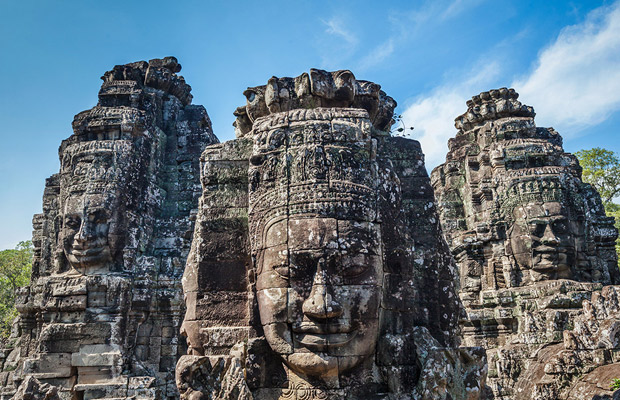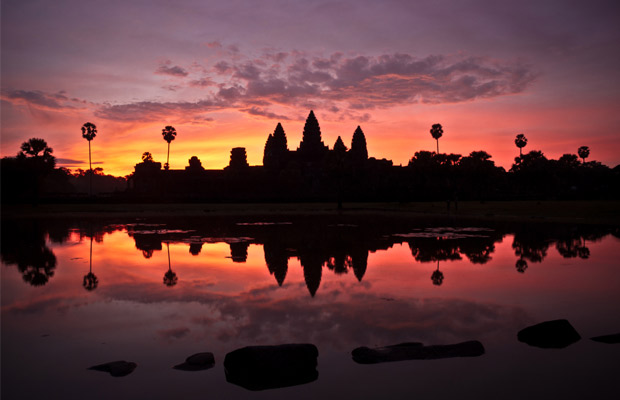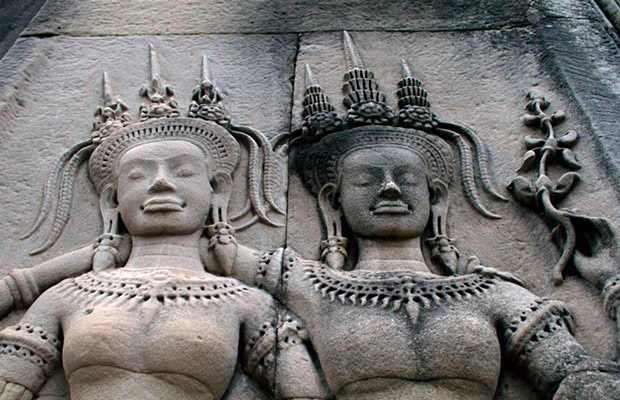Bayon Temple Trips
Bayon (Prasat Bayon) is a well-known and richly decorated Khmer temple in Angkor, Cambodia. Built in the late 12th or early 13th century as the official temple of King Mahjimana Buddhist Jayavarman VII's temple, the Bayon lies in the center of the capital of Jayavarman, Angkor Thom. After Jayavarman's death, it was modified and enlarged by Hindu and Theravada Buddhist kings, according to their own religious preferences.
Bayon (Prasat Bayon) is a well-known and richly decorated Khmer temple in Angkor, Cambodia. Built in the late 12th or early 13th century as the official temple of King Mahjimana Buddhist Jayavarman VII's temple, the Bayon lies in the center of the capital of Jayavarman, Angkor Thom. After Jayavarman's death, it was modified and enlarged by Hindu and Theravada Buddhist kings, according to their own religious preferences.
History of the Bayon Temple
Even after that, Bayon was mistakenly connected to the city of Yasovarman I and thus dated to the ninth century. A pediment found in 1925 depicting an Avalokitesvara identified Bayon as a Buddhist temple.
This discovery moved the date of the monument about 300 years until the end of century XII. Although the date is firmly established and supported by archaeological evidence, Bayon remains one of the most enigmatic temples of the Angkor group. Its symbolism, original form and subsequent changes and constructions have not yet been unleashed.
Bayon was built almost 100 years after Angkor Wat. The basic structure and the older part of the temple were not known. Since it was located in the center of a royal city, it seems that the Bayon would have originally been a temple mountain in accordance with the symbolism of a microcosm of Mount Meru. The middle part of the temple was extended during the second phase of construction. Bayon today belongs to the third and final stage of the artistic style.
The architectural scale and composition of Bayon exalt grandeur in every respect. Its elements juxtapose to create balance and harmony.
More than 2000 large faces carved in tower 54 give this temple its majestic character. Faces with slightly curved lips, eyes set in the shade by the lowered caps do not utter a word, and yet they compel him to guess much, wrote P Jennerat de Beerski in the 1920s. It is generally accepted that four faces in each tower are images of the bodhisattva Avalokitesvara and which signify the omnipresence of the king. The features of these faces - a broad forehead, drooping eyes, wild nostrils, thick lips that curl slightly at the ends - combine to reflect the famous "Smile of Angkor."
Layout and tips of the Bayon temple
+ Tip: for those who have limited time, enter the Bayon in the east, turn left in the first gallery and follow the arrow marked on the plan.
The decor on the pillars in front of the east entrance tower is characteristic of the bayon style and is exceptionally beautiful. It is the recurring theme of Apsaras, but with a different treatment. A typical composition is a group of three Asaras dancing on a lotus bed. They are in a triangular formation. The figure in the center is larger than those on both sides.
A simple background highlights both the dancers and the intricately carved picture comprising a pattern of flowers and lightly etched leaves that look like tapestries. (Although a group of three dancers is typical, similar scenes consist of only one or two dancers).
+ Tip: The absence of a roof on these pillars allows enough light for the visitor to view and photograph this motif at all times of the day.
The two galleries of bas-reliefs are distinguished by the degree of elevation.
The first gallery or the outer gallery is on one level while the second gallery or the interior is on a different level and the passage is sometimes difficult. The layout of the inner gallery may be misleading, but as loose as the relief is on display, you are still in the second gallery.
Inside the first level, there are two libraries (6), one on each side, near the corners, on the east side of the gallery.
The second gallery of bas-reliefs has a tower at each corner and another on each side that combines to form an entrance tower.
Inside the second level, there is a unit of galleries in each corner that forms a cross with indentation. Each corner has a tower and a patio. The Agigh terrace is parallel to the profile of the cross-shaped gallery.
The central mass is circular, a shape that is uncommon in Khmer art. Small balconies with pediments provide the foundation for monumental faces, while balustraded windows keep the diffusion of light to a minimum. The faces on the four sides of the tower eight that mark the cardinal directions are exceptionally dramatic representations.
The interior of the Central Shrine is and is surrounded by a narrow passageway. The summit of the central mass is undoubtedly the Golden Tower, which Zhou Daguan said, marked the center of the Kingdom and was flanked by more than twenty smaller tower and several hundred stone chambers.
View Mores Temple Guide

Pre Rup Temple
Pre Rup (Khmer: ប្រាសាទប្រែរូប) is a Hindu temple in Angkor, Cambodia, built as the state temple of King Khmer Rajendravarman [1]: 116 [2]: 73-74 [3]: 361-364 and ...

Wat Bo Pagoda
Wat Bo Pagoda, near the Siem Reap River on the east side, is one of the oldest in Siem Reap and a peaceful place to escape and take a break to visit the main sites of the nearby Angkor ...

Chau Say Tevoda
Chau Say Tevoda is a temple in Angkor, Cambodia. It is located east of Angkor Thom, directly south of Thommanon, through the Victory Path (before the previous date and post-dates). Built in the ...
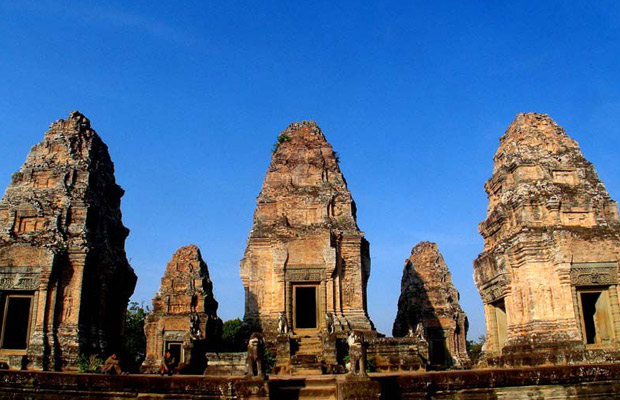
East Mebon
The East Mebon (Khmer: ប្រាសាទមេបុណ្យខាងកើត) is a 10th century temple in Angkor, Cambodia. Built during the reign of King Rajendravarman, stands on what was an ...

Prasat Thom
The main monument in Koh Ker is Prasat Thom. The stairway to the top is open to a limited number of visitors and the views are spectacular if you can stretch the heights. About 40 entries, dated from ...

Prasat Pram
This small temple is in a fair state of preservation, with three surviving sanctuary towers and two libraries. While the walls of the siege survive, the eastern gopura of the temple does not exist ...

Prasat Chrab
This temple has two circular concentric walls. Three large laterite towers standing in a line rise in the center. Facing these are the remains of two prasats of ...
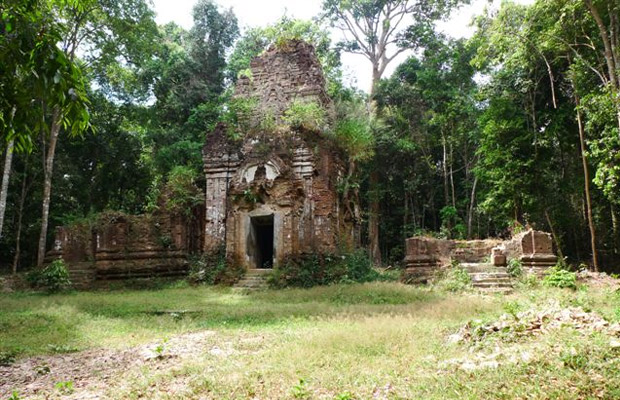
Prasat Damrei Krap
Prasat Damrei Krap is a temple with three towers. The main entrance is the east side. The condition of the central tower is relatively ...

Kampong Khleang Floating Village
Kampong Khleang is a village in Cambodia, situated on Tonle Sap Lake. Most of the community lives in stilt houses. This creates a unique feeling. Kampong Khleang is a must visit during your trip to ...
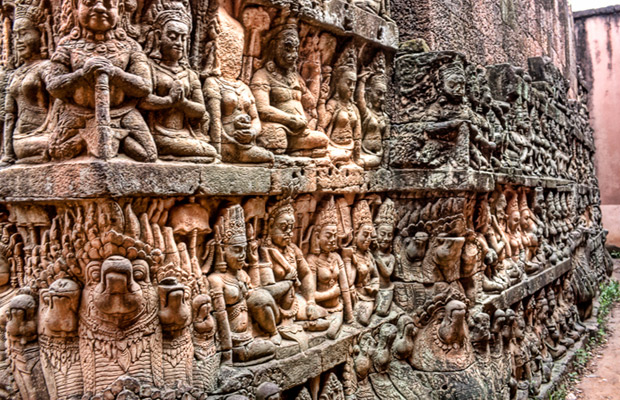
Terrace of the Leper King
Leper King Terrace (Khmer: ព្រះ លាន ស្តេ ច គម្លង់, Preah Learn Sdech Kunlung) is located in the north-west corner of the Royal Square of Angkor Thom in Cambodia. ...
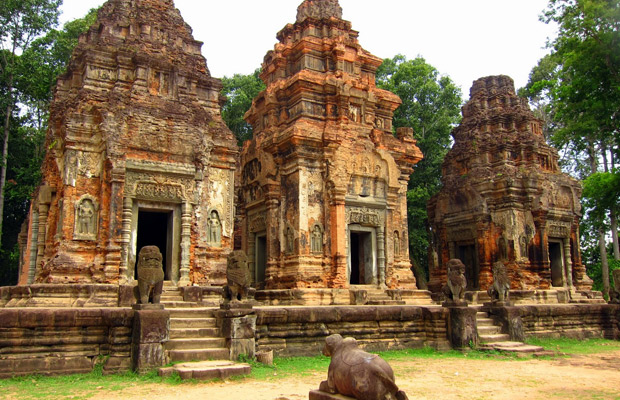
Preah Ko Temple
Preah Ko (Khmer: The Sagred Bull) was the first temple to be built in the ancient and now extinct city of Hariharalaya (in the area now called Roluos), about 15 kilometers southeast of the main Group ...
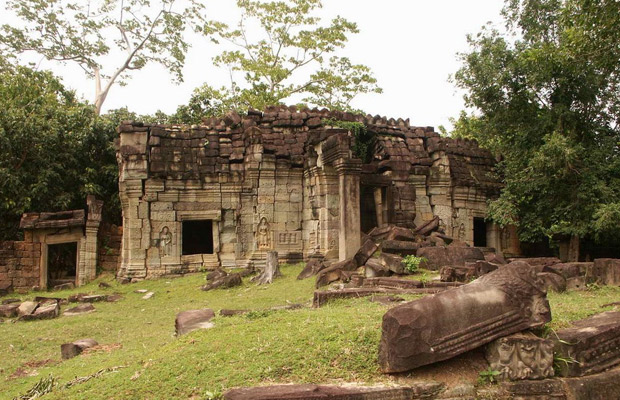
Banteay Thom
Banteay Thom is a lovely temple where the main appeal is its rural setting; It is only reached by sandy trails through rice and bush, where you are likely to seek a farmer, a buggy or anyone on the ...



